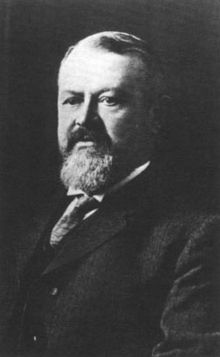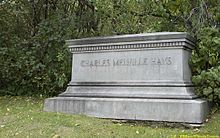- Charles Melville Hays
-
Charles Melville Hays 
Charles Melville HaysBorn May 16, 1856
Rock Island, IllinoisDied April 15, 1912 (aged 55)
North AtlanticCharles Melville Hays (May 16, 1856 – April 15, 1912) was an American railway executive of the Grand Trunk Railway. He died at sea on the RMS Titanic.
Contents
Biography
Early years
Born at Rock Island, Illinois, Hays began working for the Atlantic and Pacific Railroad in St. Louis, Missouri, at the age of 17 in 1873. In 1878 Hays became secretary to the general manager of the Missouri Pacific Railroad and took a similar position in 1884 with the Wabash, St. Louis and Pacific Railway.
Charles Melville Hays was a native of Rock Island, Illinois but lived in Canada for many years. He became general manager of the Grand Trunk Pacific Railway in 1896 and convinced the Canadian Prime Minister of the need for a second transcontinental railroad. Obtaining the financing for the project proved difficult, however, and by 1911 the company was facing bankruptcy. Obtaining the financing for the projects that could solve their financial woes. He intended to spend the Easter holidays with his daughter and son-in-law in Paris, and his wife joined him for the trip. News that one of his daughters in Canada was having a difficult pregnancy was among the reasons prompting the Hays to return home on Titanic's maiden voyage. He died at age 55, boarded at Southampton, England and the destination was Montreal,Quebec, Canada
Career
In 1887 Hays became general manager of the Wabash Western Railroad and of the entire Wabash Railroad in 1889.
In an 1895 reorganization of the Grand Trunk, Hays was appointed general manager effective January 1, 1896. Except for an interruption in 1901, Hays was general manager of the Grand Trunk from 1899 to 1910. In 1904 Hays was also appointed president of Grand Trunk subsidiary Grand Trunk Pacific, then under construction from Winnipeg, Manitoba, to Prince Rupert, British Columbia. Hays became president of the entire Grand Trunk system in 1909, a position he held until his death.
Arriving in Canada during a time of economic recession, Hays sought to restructure the management and operations of the Grand Trunk system and implemented a more aggressive, American railroading approach which is credited in part for a period of unprecedented growth during the first decade of the 20th century.
Hays sought to have the Grand Trunk compete with the Canadian Pacific (CPR) on the prairies where an immigration boom was recording record traffic. In 1899, William Mackenzie and Donald Mann had amalgamated a number of systems into the Canadian Northern Railway (CNoR) and spurned federal government offers of assistance in coordinating the construction of a second transcontinental railway, preferring instead to go it alone.
Hays forced the Grand Trunk to reconsider federal offers to assist in building a transcontinental system, something that the company had rejected in the 1870s, which had forced the federal government to go with the CPR. Having realized the error in not expanding west, Hays accepted the offer of Sir Wilfrid Laurier's government to build a system from Prince Rupert to Moncton, New Brunswick, to be called the Grand Trunk Pacific.
In October 1903 the National Transcontinental Railway Act was passed by Parliament and Hays became heavily involved in supervising construction of the line west of Winnipeg (the Grand Trunk Pacific). While the Grand Trunk agreed to build the line west of Winnipeg, the federal government assumed responsibility for constructing the line from Winnipeg to Moncton, including the infamous and costly Quebec Bridge crossing of the St. Lawrence River, with the Grand Trunk initially agreeing to operate the entire line as a single system.
Turning of the first sod for the construction of the GTP took place at an official ceremony, September 11, 1905, at Fort William, Ontario, by the prime minister, Wilfrid Laurier. From there a 190-mile section of track was built by the Grand Trunk Pacific Construction Company, connecting with the NTR, near Sioux Lookout.
The GTP proved to be controversial for Hays as he was criticized for various decisions, such as choosing Prince Rupert as the Pacific terminus, underestimating Mackenzie and Mann's competing CNoR system, and committing the entire Grand Trunk company to the GTP project. Hays's zeal to pursue construction of a well-engineered mainline in lieu of developing a network of branchlines for feeding local traffic proved to be a considerable hurdle as well.
As president of the Grand Trunk, Hays committed to competing with the CPR in a number of other areas, namely shipping and hotels. In fact Hays died while returning from a visit to England to Canada where he was scheduled to attend the April 26, 1912, grand opening of the Château Laurier hotel in Ottawa, Ontario. Hays had chosen to return from England on the maiden voyage of the ocean liner RMS Titanic, which struck an iceberg south of the Grand Banks of Newfoundland the night of April 14 and sank.
Not long after Hays' death, the Grand Trunk reneged on its agreement to operate the federally owned National Transcontinental system east of Winnipeg, and the Grand Trunk soon faced financial ruin over its decision to build and operate the GTP west of Winnipeg, particularly after the First World War caused traffic on the prairies to decline precipitously.
Personal life
On October 13, 1881 Hays married 22-year-old Clara Jennings Gregg in St. Louis, Missouri. They would have four daughters: Orian (Mrs. Thornton Davidson), Clara (Mrs. Hope Scott), Marjorie (Mrs. George Hall), and Louise (Mrs. Grier).
Hays was one of the 1,517 victims of the Titanic disaster; his body was subsequently recovered from the waters of the North Atlantic for burial in Mount Royal Cemetery in Montreal. On April 25, 1912, the entire Grand Trunk system came to a halt for a five minute tribute to the company's past president. Hays never lived to see the completion of the GTP project on April 7, 1914, or the opening of the Château Laurier on June 12, 1912. His widow never remarried and died in 1955.
Legacy
- Local Ottawa folklore suggests that Hays's ghost is rumoured to haunt the hotel that he was scheduled to open.
- Charles Hays Secondary School, located in Prince Rupert, British Columbia, was named after Hays.
- Melville, Saskatchewan, a divisional point on the Grand Trunk Pacific route, was named after Hays.
External links
Presidents of the Southern Pacific Railroad Timothy Guy Phelps (1865) · Charles Crocker (1868) · Leland Stanford (1885) · Collis Potter Huntington (1890) · Charles Melville Hays (1900) · E. H. Harriman (1901) · Robert S. Lovett (1909) · William Sproule (1911) · Julius Kruttschnitt (1918) · William Sproule (1920) · Paul Shoup (1929) · Angus Daniel McDonald (1932) · Armand Mercier (1941) · Donald J. Russell (1952) · Benjamin Biaggini (1964) · Denman McNear (1976) · Alan Furth (1979) · Robert Krebs (1982) · D. M. Mohan (1984)
Preceded by
Charles Rivers WilsonPresident of the Grand Trunk Railway
1910-1912Succeeded by
Edson Joseph ChamberlinCategories:- 1856 births
- 1912 deaths
- People from Rock Island, Illinois
- Deaths on the RMS Titanic
- Grand Trunk Railway executives
- RMS Titanic's crew and passengers
- People lost at sea
Wikimedia Foundation. 2010.

